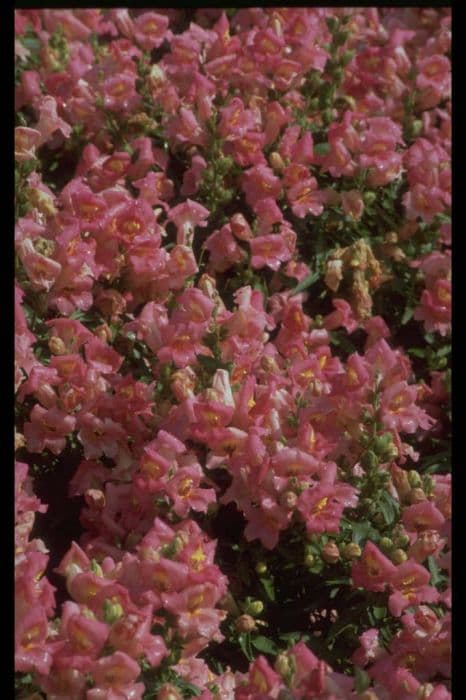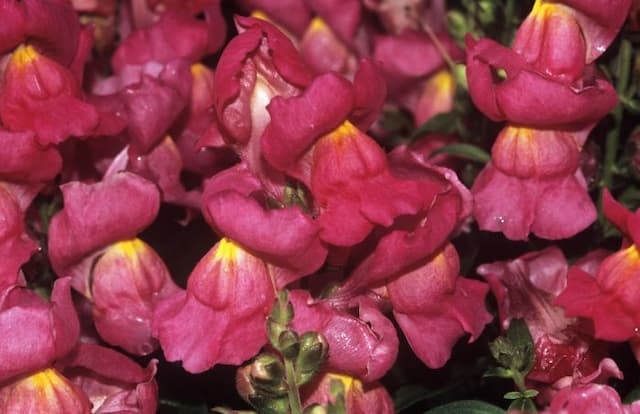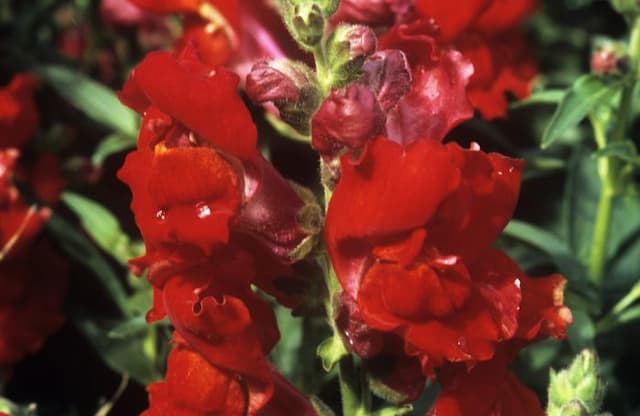Foothill Penstemon Penstemon heterophyllus 'Heavenly Blue'

ABOUT
Penstemon heterophyllus 'Heavenly Blue', commonly known as Foothill Penstemon, is a visually striking plant notable for its vibrant flowers and attractive foliage. The plant exhibits an upright habit, with stems that hold the blooms proudly above the surrounding greenery. The foliage consists of narrow, glossy leaves that are lance-shaped, providing a lush backdrop for the prominent flowers. The most eye-catching feature of Foothill Penstemon is its blossoms. The flowers boast a dazzling shade of blue, which can have varying hues from sky to violet-blue, often with a gradient of color that adds depth and allure to the display. The tubular shape of the blossoms is characteristic, each with a slightly flared mouth, creating a bell-like appearance that is both elegant and alluring. This floral arrangement is favored by hummingbirds and bees, which are attracted to the rich source of nectar. Throughout the blooming period, the Foothill Penstemon becomes a spectacle of color that brings dynamic visual interest to any garden setting. The contrast between the greenery and the intense blue of the flowers generates a serene and attractive tableau, making this plant a sought-after choice for gardeners seeking to inject a pop of color into their landscapes without overwhelming the senses.
About this plant
 Names
NamesFamily
Plantaginaceae
Synonyms
Foothill Penstemon, Blue Bedder Penstemon, Bundled Penstemon, Chaparral Penstemon, Fragrant Blue Penstemon, Heavenly Blue Penstemon
Common names
Penstemon heterophyllus var. australis, Penstemon azureus var. heterophyllus.
 Toxicity
ToxicityTo humans
Foothill penstemon is generally not recognized as a poisonous plant to humans. There is no widespread documentation on the toxicity of this plant causing adverse effects after ingestion. However, as with any plant not commonly recognized as edible, caution should always be observed as individual allergies or sensitivities can occur.
To pets
Foothill penstemon is not commonly known to be toxic to pets such as dogs and cats. There is limited information available on the plant's potential toxicity, but it is not listed as a common poisonous plant to domestic animals. Nonetheless, pet owners should always be cautious and prevent pets from consuming plants not meant for ingestion, as individual reactions can vary.
 Characteristics
CharacteristicsLife cycle
Perennials
Foliage type
Evergreen
Color of leaves
Green
Flower color
Blue
Height
1-2 feet (30-60 cm)
Spread
1-2 feet (30-60 cm)
Plant type
Herb
Hardiness zones
6-9
Native area
California
Benefits
 General Benefits
General Benefits- Attracts Pollinators: Provides a valuable nectar source for bees and butterflies, enhancing pollination in the garden.
- Drought Tolerance: Once established, it requires minimal water, making it suitable for xeriscaping or drought-prone areas.
- Easy to Grow: It's known for being a hardy plant that doesn't need much care, making it a good choice for novice gardeners.
- Long Blooming Period: Flowers from late spring to early summer, offering a prolonged display of color.
- Deer Resistance: Typically not favored by deer, which can be helpful in gardens troubled by wildlife browsing.
- Non-Invasive: Grows in clumps and doesn't tend to spread uncontrollably, which makes it garden-friendly.
- Attractive Foliage: The lance-shaped leaves provide textural interest even when the plant is not in bloom.
- Versatility: Suitable for use in borders, rock gardens, and as ground cover due to its mounding habit.
- Cold Hardy: Can survive in cooler climates, which makes it adaptable to various garden zones.
- Colorful Varieties: 'Heavenly Blue' offers striking blue flowers that can complement a range of garden color schemes.
 Medical Properties
Medical PropertiesThis plant is not used for medical purposes.
 Air-purifying Qualities
Air-purifying QualitiesThis plant is not specifically known for air purifying qualities.
 Other Uses
Other Uses- Penstemon can be used as a colorful dye for fabrics, with different parts of the plant producing various shades of blue and purple.
- When dried, the flowers of Penstemon serve as a decorative addition to potpourri mixes, contributing a subtle scent and vibrant color.
- The plant, due to its attractive flowers, is often featured in floral photography and plant illustration workshops that emphasize botanic artistry.
- The dense foliage can be utilized in creating small-scale garden models or fairy gardens as a representation of larger shrubbery or trees.
- Penstemon seed pods can be included in craft projects, such as making natural jewelry or as an addition to wreaths and other botanical arrangements.
- The plant is sometimes included in educational activities for children, teaching them about pollination and the growth cycle of flowering plants.
- Penstemon can be used as a natural confetti for garden parties or eco-friendly celebrations, where the petals can be scattered without harming the environment.
- These plants can be used to add aesthetic value to green roofs or living walls because of their vibrant blooms and adaptability to various soil conditions.
- Penstemon leaves, when pressed and dried, are sometimes incorporated into handmade papers, adding texture and visual interest.
- Garden enthusiasts might employ Penstemon in companion planting strategies to draw beneficial insects that help with pest control.
Interesting Facts
 Feng Shui
Feng ShuiThe plant Penstemon is not used in Feng Shui practice.
 Zodiac Sign Compitability
Zodiac Sign CompitabilityThe plant Penstemon is not used in astrology practice.
 Plant Symbolism
Plant Symbolism- Attraction and Charm: The striking blue color of Foothill Penstemon is often associated with enchantment and attraction, making it symbolic for those who wish to charm or captivate others.
- Communication: The tubular shape of flowers, which can resemble a loudspeaker, might symbolize the importance of communication and the expression of thoughts and feelings.
- Diversity and Uniqueness: Penstemon heterophyllus 'Heavenly Blue' offers a range of colors and diversity in its blooms, representing individual uniqueness and the beauty of diversity in life.
- Endurance and Hardiness: As this plant is known for its ability to thrive in less-than-ideal conditions, it can symbolize endurance and the ability to withstand hardships.
- Health and Vitality: Foothill Penstemon is also known for its therapeutic properties in traditional medicine, hence it might be symbolic of good health and vitality.
 Water
WaterFoothill penstemon needs to be watered moderately; during the growing season, provide deep watering once a week to encourage a robust root system. Ensure the soil is well-draining to prevent waterlogged conditions. As it is a drought-tolerant species after establishment, you can reduce watering to every two to three weeks, depending on weather conditions. A good rule of thumb is to water when the top 1-2 inches of soil feels dry to the touch. Avoid light, frequent watering, and instead aim for about one gallon of water per plant for each watering session.
 Light
LightFoothill penstemon thrives in full sun to partial shade conditions. It prefers a location that receives at least six hours of direct sunlight per day. Although it can tolerate some light shade, particularly in hot, dry regions, blooming is most prolific with ample sunlight. Place it in a spot where it can receive morning sun and some afternoon shade in extremely hot climates for optimal growth.
 Temperature
TemperatureFoothill penstemon is hardy and can survive in a range of temperatures; ideally, it grows best when daytime temperatures are between 60 and 85 degrees Fahrenheit. It can withstand minimum temperatures down to about 10 degrees Fahrenheit, making it suitable for many temperate climates. Optimal growth occurs when night temperatures are cooler than day temperatures, but avoid prolonged exposure to temperatures below freezing.
 Pruning
PruningPruning foothill penstemon promotes healthy growth and abundant flowering; it should be pruned after the main flowering period to maintain its shape and encourage a second bloom. Deadhead spent flowers regularly to prolong the flowering season. In early spring or after flowering, trim back about a third of the growth to keep it bushy and prevent it from getting leggy.
 Cleaning
CleaningAs needed
 Soil
SoilFoothill Penstemon thrives in well-draining, slightly acidic to neutral soil with a pH of 5.8 to 7. For potting mix, use a blend of loamy soil, coarse sand, and compost to ensure good drainage and aeration, which are critical for healthy root development.
 Repotting
RepottingFoothill Penstemon doesn't require frequent repotting and can be done every 2-3 years. It's best to repot only when the plant has outgrown its current container or if the soil has become compacted and needs refreshing.
 Humidity & Misting
Humidity & MistingFoothill Penstemon prefers moderate humidity conditions but is quite adaptable and can tolerate drier air without issue. Strive for a humidity level that mimics its natural habitat, which does not require high humidity levels to thrive.
 Suitable locations
Suitable locationsIndoor
Provide bright light, good airflow, and avoid overwatering.
Outdoor
Full sun to partial shade, well-draining soil, and regular deadheading.
Hardiness zone
6-9 USDA
 Life cycle
Life cyclePenstemon heterophyllus 'Heavenly Blue', also known as Foothill Penstemon, begins its life as a seed, which germinates in late winter to early spring under the right conditions of moisture and temperature. Seedlings emerge and establish a root system before developing a rosette of leaves, and as they mature over several weeks to months, they develop a more extensive root system and foliage. In late spring to early summer, the plant produces flowering stems, with bright blue to violet flowers that attract pollinators such as bees and hummingbirds. After pollination, flowers develop into seed capsules, which eventually dry and release seeds in late summer to early fall, completing the reproductive cycle. Throughout the growing season, the Foothill Penstemon experiences vegetative growth, with foliage dying back in the winter in colder climates, while in milder climates it may remain evergreen. With proper care and favorable conditions, Foothill Penstemon can live several years, often dying back in the winter and re-emerging each spring.
 Propogation
PropogationPropogation time
Spring to Summer
The most popular method for propagating Penstemon, often known as Beardtongue, specifically the Penstemon heterophyllus 'Heavenly Blue', is through seed sowing. This is usually done in late winter to early spring. Sow the seeds shallowly, barely covering them with soil, as they require light to germinate. The seed tray should be kept under indirect light at a temperature of about 60-70 degrees Fahrenheit (15.6-21.1 degrees Celsius). Germination can take 2 to 4 weeks. Once seedlings are large enough to handle, they can be potted on and gradually acclimatized to outdoor conditions before planting out after the risk of frost has passed.









